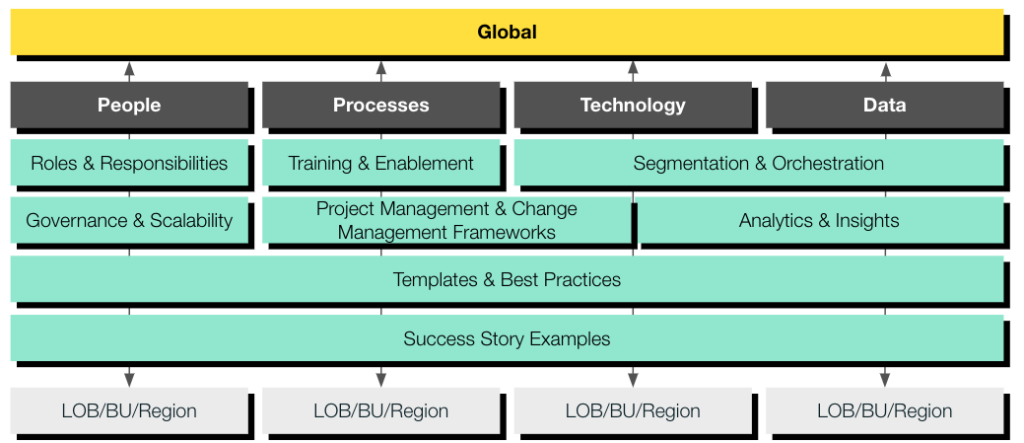Decentralized Marketing and the COE That Holds it Together

As businesses go through acquisitions/mergers and look to expand into new markets, often the organization shifts towards decentralized marketing teams. This structure can be necessary to better support different departments, lines of business and regions, and will normally be less expensive and agile. Increased specialization and subject matter expertise is one of the bigger advantages of a decentralized marketing structure.
The disadvantages to this structure may include a lack of cohesive strategy, duplicative work, the feeling of being stretched thin, and varying levels of support and disconnect from the overall business goals.
These growing pains have solutions such as hybrid approaches, outsourcing and increasing headcount; and oftentimes some of these solutions will be necessary. But with a tight budget and a need for quick operational efficiencies with what an organization has, a Center of Excellence (COE) may be the perfect fit.
What defines a COE?
As mentioned in our article “Center of Excellence: The Tool of Great Marketing Teams”, ‘Gartner describes a COE as a “physical or virtual center of knowledge concentrating existing expertise and resources in a discipline or capability to attain and sustain world-class performance and value.”’ Though I agree with this definition, I believe they left out the productivity gained through COE operations and processes.
First, I’d like to disprove the common misconception that COEs have been designed for centralized orgs. They can be effective in a centralized setting, but we’re seeing more need for, and success with COEs in organizations with complexities and decentralization.
- The COE team may be completely centralized or it may be composed of individuals representing both centralized and decentralized units.
- COEs do not dictate what the decentralized units have to do, they provide processes and tools to partner with these teams/individuals, with an understanding that there will be a need for customization.
COE Components
COEs have different goals and purposes (different departments for instance). The visual below shows some of the components that may be included when we work on standing up COEs for marketing operations.

See how the COE practices flowing down to the decentralized units but also back up? This shows how effective feedback loops are established to support the COE to provide the greatest value. The COE coupled with good change management processes makes it a powerful marketing resource.
A few examples:
- A new marketing automation platform was purchased at the global level of an organization and needs to be implemented and rolled out to all regions.
A. Actions: In this use-case the COE would likely play more of a change management role—in making local teams aware of the upcoming tech change, collecting user requirements, communicating the rollout and training plans, and reinforcing the use of the platform.
b. Impact: Reducing technology redundancies and duplication, understanding unique regional requirements for the tech, and ensuring adoption to support regions in marketing campaigns. - A BU runs an effective multi-touch campaign—seeing great ROI.
a. Actions: Here the COE team may vet the submission, format the campaign materials, and templatize some of what was used. The team may also add to a centralized success hub and share out to corporate and other BUs
b. Impact: Other departments sometimes reuse (with some customization) to recognize more impactful campaigns, go to market quicker, and reduce spend in some of the planning and campaign development areas.
How to Prove Effectiveness and Investment
A few prioritized use-cases demonstrate and prove that the ROI of a COE will be worth the investment . Qualities to look for may include:
- Saving time (and therefore money) to launch, change, and work
- Decreasing costs due to removing duplicative work and inefficiencies
- Better alignment between teams
- Increased work satisfaction
- Better customer experience due to an increase of cohesive strategy and messaging
- Invest and continue to evolve to see returns. If you stand something up that is hard to navigate, versioning becomes a pain, team members don’t commit, and it won’t be adopted.
Invest and continue to evolve to see returns. If you stand something up that is hard to navigate, versioning becomes a pain, team members don’t commit, and it won’t be adopted.
Visualize Your Decentralized Digital Marketing Strategy With Us
As you scale, you might still recognize the need to hire and grow the team. Remember the COE will get you started on the right track and even better inform those hiring decisions. Shift Paradigm is a full-service partner for any organization that wants to stay agile in the current digital landscape. Our strategy services provide the complete package to create your enterprise’s ideal decentralized digital marketing strategy. Want to know more about COEs that could help your business drive success? Let’s connect!


